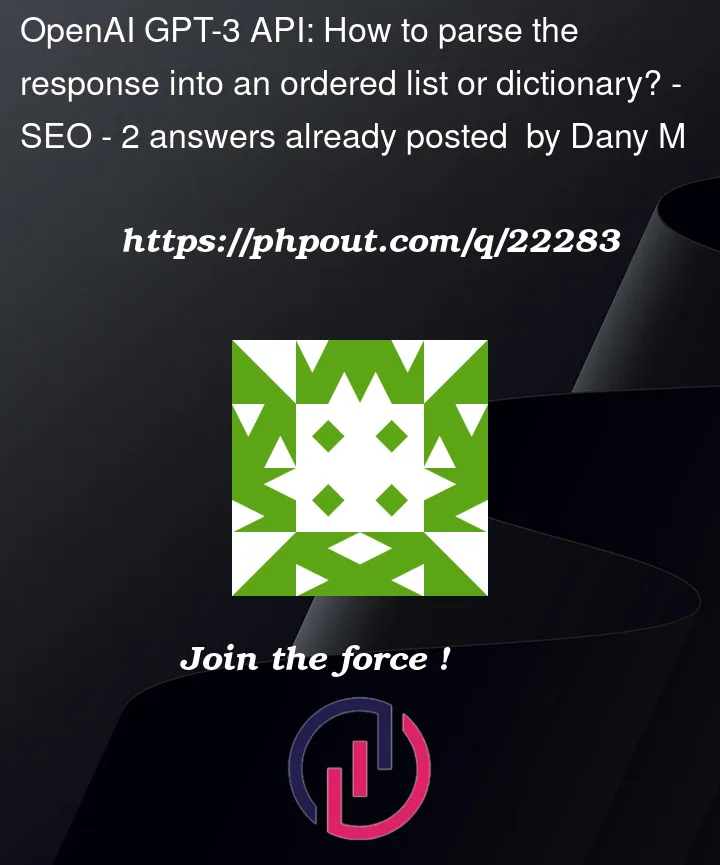GPT-3 is amazing, but parsing its results is a bit of a headache, or I’m missing something here?
For example, I’m asking GPT-3 to write something about "digital marketing" and it’s returning back some interesting stuff:
nn1. Topic: The Benefits of Digital Marketing nHeadlines: na. Unlocking the
Potential of Digital Marketing nb. Harnessing the Power of Digital Marketing for
Your Business nc. How to Maximize Your Return on Investment with Digital Marketing
nd. Exploring the Benefits of a Comprehensive Digital Marketing Strategy ne.
Leveraging Technology to Take Your Business to the Next Level with Digital Marketing
nn2. Topic: Social Media Strategies for Effective Digital Marketing nHeadlines:
na. Crafting an Engaging Social Media Presence for Maximum Impact nb. How to Reach
and Engage Your Target Audience Through Social Media Platforms nc. Optimizing Your
Content Strategy for Maximum Reach on Social Media Platforms nd. Utilizing Paid
Advertising Strategies on Social Media Platforms ttttttt e .Analyzing
and Improving Performance Across Multiple Social Networksnn3. Topic: SEO Best
Practices for Effective Digital Marketing Headlines: a .Understanding Search
Engine Algorithms and Optimizing Content Accordingly b .Developing an Effective
SEO Strategy That Delivers Results c .Leveraging Keywords and Metadata For Maximum
Visibility d .Exploring Advanced SEO Techniques To Increase Traffic e .Analyzing
Performance Data To Improve Rankingsnn4Topic : Email Campaigns For Successful
Digital Marketin g Headlines : a .Creating Compelling Email Campaigns That Drive
Results b .Optimizing Email Deliverability For Maximum Impact c .Utilizing Automation
Tools To Streamline Email Campaign Management d .Measuring Performance And Analyzing
Data From Email Campaigns e .Exploring Creative Ways To Increase Open Rates On
Emailsnn5Topic : Mobile Advertising Strategies For Effective Digita l Marketin g
Headlines : a ..Maximizing Reach With Mobile Ads b ..Understanding User Behavior On
Mobile Devices c ..Optimizing Ads For Different Screen Sizes d ..Leveraging Location-
Based Targeting To Increase Relevance e ..Analyzing Performance Data From Mobile Ads
As you can see, it’s sent me back a list of topics related to "digital marketing" with some headlines (apparently from a to e). I see some line breaks and tabulation here and there. So my first reflex was to split the text on the line breaks, but it looks like the format is not equal everywhere, as there are very few line breaks in the second half of the response (which make it inaccurate).
What I’d like to do, is reformatting the output, so I can have a kind of list of topics and headlines. Something like this:
[
{"Topic 1": ["headline 1", "headline 2","..."]},
{"Topic 2": ["headline 1", "headline 2","..."]},
{"Topic 3": ["headline 1", "headline 2","..."]}
]
Maybe there is a parameter to send over withing my request, but I didn’t find anything in the doc. So I guess my best bet is to reformat using regex. Here I see a pattern Topic:and Headlines: but it’s not always the case. What is consistent is the number prefixing each element (like Ì., II., 1., 2. or a., b.) but sometimes it looks like a .. (you can see that at the end of the response for example.
Any idea how to do that? (I’m using python for that, but can adapt from another language)




2
Answers
Use the Edits endpoint
If you run
test.pythe OpenAI API will return the following completion:test.py
You can get GPT to provide the response in JSON format you just need to train it as part of the prompt. Here is an example prompt:
Provide a list of 3 topics related to climate change and for each topic provide 3 headlines.
Your response should be in JSON format. Here is the expected JSON format:
END PROMPT
You might have to play around with the prompt a little bit, but I have been successful in building email parsers that return the responses in JSON.